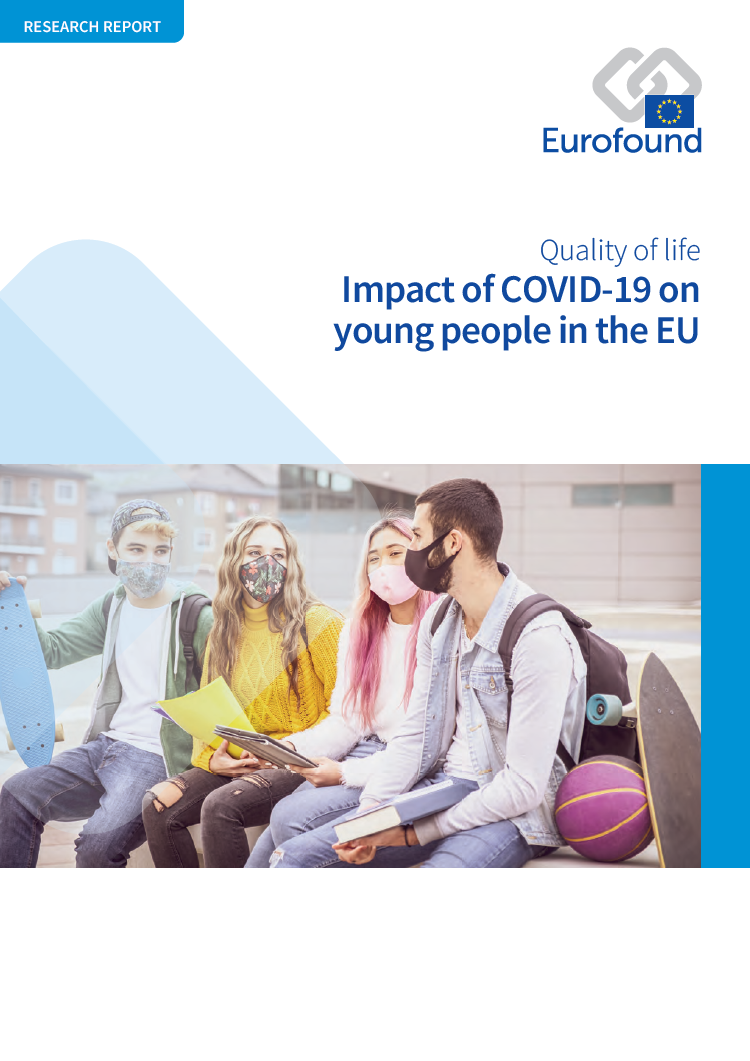
Following a long recovery from the economic crisis (2007–2013), young people in the EU proved to be more vulnerable to the effects of the restrictions put in place to slow the spread of the COVID-19 pandemic. Young people were more likely than older groups to experience job loss, financial insecurity and mental health problems. They reported reduced life satisfaction and mental well-being associated with the stay-at-home requirements and school closures. While governments responded quickly to the pandemic, most efforts to mitigate the effects of restrictions were temporary measures aimed at preventing job loss and keeping young people in education. This report explores the effects of the pandemic on young people, particularly in terms of their employment, well-being and trust in institutions, and assesses the various policy measures introduced to alleviate these effects.
Key findings
Despite EU and Member State policy efforts to support young people in the wake of the 2008 financial crisis, young people were also hardest hit by job loss during the COVID-19 crisis. Overrepresented in the sectors most impacted by pandemic restrictions and more likely to work on temporary contracts or part time, 12% of 18- to 29-year-olds who responded to at least two rounds of the Living, working and COVID-19 e-survey reported that they had lost their job, with 12% of students also facing unemployment.
Unemployed or inactive young people were most likely to experience housing insecurity than other groups during the pandemic (17% in spring 2021) and reported difficulty making ends meet (43%), as well as having no savings (39%); however, over half of young people reported living with their parents, which provided some security. Unless young people can participate actively in education and the labour market there is a high risk of their long-term disengagement with serious implications for their and society’s future.
The COVID-19 crisis had a disproportionate impact on young people’s life satisfaction and mental well-being compared to older groups. This improved between spring and summer 2020 when lockdowns eased but dropped to its lowest point in spring 2021 when restrictions and school closures returned, contributing to a decrease in life satisfaction and mental well-being where nearly two-thirds of young people were at risk of depression.
Young people’s trust in institutions overall also remained higher than other groups despite being hardest hit by the COVID-19 crisis in terms of mental health and employment. It will be important for policymakers to build on this social capital and ensure investment in youth remains at the top of the EU policy agenda.
A wide range of measures were introduced to support young people during the pandemic. These included the reinforced European Youth Guarantee, national initiatives to keep young people in education, and measures to reduce barriers to existing financial support and social protection specifically for young people; however, many of these policy responses were temporary. To ensure greater resilience in future crises, it will be crucial for policymakers to prioritise long-term measures for young people, such as permanent improvements in access to work and apprenticeships and measures to increase job security.
The report contains the following tables and figures.
List of tables
Table 1: Proportions of workers aged 15–29 and aged 30+ employed by sector (NACE Rev. 2), 2019 (%)
Table 2: Decrease in the job vacancy rate between 2019 and 2020 in the three most affected sectors by Member State (percentage points)
Table 3: NEET rate by level of education among 15- to 29-year-olds, 2007–2020 (%)
Table 4: NEET rate by age range, 2007–2020 (%)
Table 5: Breakdown of NEETs aged 15–29 as a proportion of all young people, EU27, 2013 and 2019 (%)
Table 6: Proportions of young people who asked for and who received informal support by need for/availability of formal support (%)
Table 7: Life satisfaction among young people during the pandemic (score out of 10)
Table 8: Mental well-being among young people during the pandemic (score out of 25)
Table 9: Trust in government among young people during the pandemic (score out of 10)
Table 10: Trust in the EU among young people during the pandemic (score out of 10)
Table 11: Key challenges of the COVID-19 crisis for young people and policy reactions in EU Member States
Table 12: Categories of measures to improve the economic, employment and mental health situation of young people in the context of the COVID-19 crisis
List of figures
Figure 1: Unemployment rate, young people and total population, EU27, 2007–2020 (%)
Figure 2: Youth unemployment ratio by Member State, 2019 and 2020 (%)
Figure 3: Beveridge curve – job vacancies versus unemployment rate, EU27, 2010–2020
Figure 4: Decrease in the job vacancy rate between 2019 and 2020 by sector, EU27 (percentage points)
Figure 5: NEET rate among 15- to 29-year-olds, 2020 map and time series since 2011, EU27 (%)
Figure 6: Breakdown of NEETs aged 15–29, EU27, 2013 and 2019 (%)
Figure 7: Composition of NEETs before and during the COVID-19 pandemic, EU27 (’000)
Figure 8: Proportion of respondents aged 18–29 and 30+ who became unemployed during the pandemic, spring 2020 to spring 2021 (%)
Figure 9: Sankey diagram – employment status transitions among young people during the pandemic (%)
Figure 10: Sankey diagram – employment status transitions among young people during the pandemic, restricted sample of 766 unique individuals
Figure 11: Proportion of young people transitioning from employment into unemployment during the pandemic by country group (%)
Figure 12: Proportion of young people transitioning from employment into unemployment during the pandemic by Member State (%)
Figure 13: Predicted probability of job loss among young people during the pandemic across time and sociodemographic groups
Figure 14: Predicted probability of job loss among young people during the pandemic across country groups
Figure 15: Proportion of young people transitioning from education into unemployment during the pandemic by country group (%)
Figure 16: Proportion of young people transitioning from education into unemployment during the pandemic by Member State (%)
Figure 17: Predicted probability of transitioning to unemployment from student status during the pandemic across time and sociodemographic groups
Figure 18: Predicted probability of transitioning to unemployment from student status during the pandemic across country groups
Figure 19: Proportion of young people who became unemployed during the pandemic by country group (%)
Figure 20: Proportion of young people who became unemployed during the pandemic by Member State (%)
Figure 21: Predicted probability of becoming unemployed among young people during the pandemic across time and sociodemographic groups
Figure 22: Predicted probability of becoming unemployed among young people during the pandemic across country groups
Figure 23: Proportions of young people experiencing financial insecurity during the pandemic by employment status (%)
Figure 24: Proportions of young people experiencing difficulties by need for/availability of financial support, spring 2021 (%)
Figure 25: Proportions of young people aged 18–29 at risk of depression and feeling socially excluded by employment status and living situation, spring 2021 (%)
Figure 26: Predicted levels of life satisfaction among young people during the pandemic in relation to restrictive measures and across time (score out of 10)
Figure 27: Predicted levels of life satisfaction among young people during the pandemic across country groups (score out of 10)
Figure 28: Predicted levels of life satisfaction among young people during the pandemic across sociodemographic groups (score out of 10)
Figure 29: Proportions of people at risk of depression during the pandemic, based on WHO-5 mental well-being score, by age group (%)
Figure 30: Feeling tense, lonely or depressed ‘all or most of the time’, by gender and survey round (%)
Figure 31: Predicted levels of mental well-being among young people during the pandemic in relation to restrictive measures and across time (score out of 25)
Figure 32: Predicted levels of mental well-being among young people during the pandemic across country groups (score out of 25)
Figure 33: Predicted levels of mental well-being among young people during the pandemic across sociodemographic groups (score out of 25)
Figure 34: Predicted levels of trust in government among young people during the pandemic in relation to restrictive measures and across time (score out of 10)
Figure 35: Predicted levels of trust in government among young people during the pandemic across country groups (score out of 10)
Figure 36: Predicted levels of trust in government among young people during the pandemic across sociodemographic groups (score out of 10)
Figure 37: Predicted levels of trust in the EU among young people during the pandemic in relation to restrictive measures and across time (score out of 10)
Figure 38: Predicted levels of trust in the EU among young people during the pandemic across country groups (score out of 10)
Figure 39: Predicted levels of trust in the EU among young people during the pandemic across sociodemographic groups (score out of 10)
Figure 40: Proportions of people aged 18–29 agreeing or strongly agreeing with the statement ‘I am optimistic about my future’, spring 2020 to spring 2021, by Member State (%)
Figure 41: Proportions of people aged 18–29 feeling optimistic about their own future, spring 2020 to spring 2021, by experience of job, housing and financial insecurity (%)
Figure 42: Number of measures in each category by target beneficiaries
Figure 43: Funding sources for the measures identified (number of measures)
Figure 44: Key actors involved in designing and launching the measures (number of measures)
- Number of pages
-
92
- Reference nº
-
EF20036
- ISBN
-
978-92-897-2209-4
- Catalogue nº
-
TJ-01-21-315-EN-N
- DOI
-
10.2806/361465
- Permalink
Cite this publication
Eurofound (2021), Impact of COVID-19 on young people in the EU, Publications Office of the European Union, Luxembourg.
